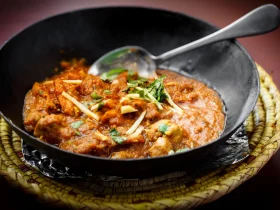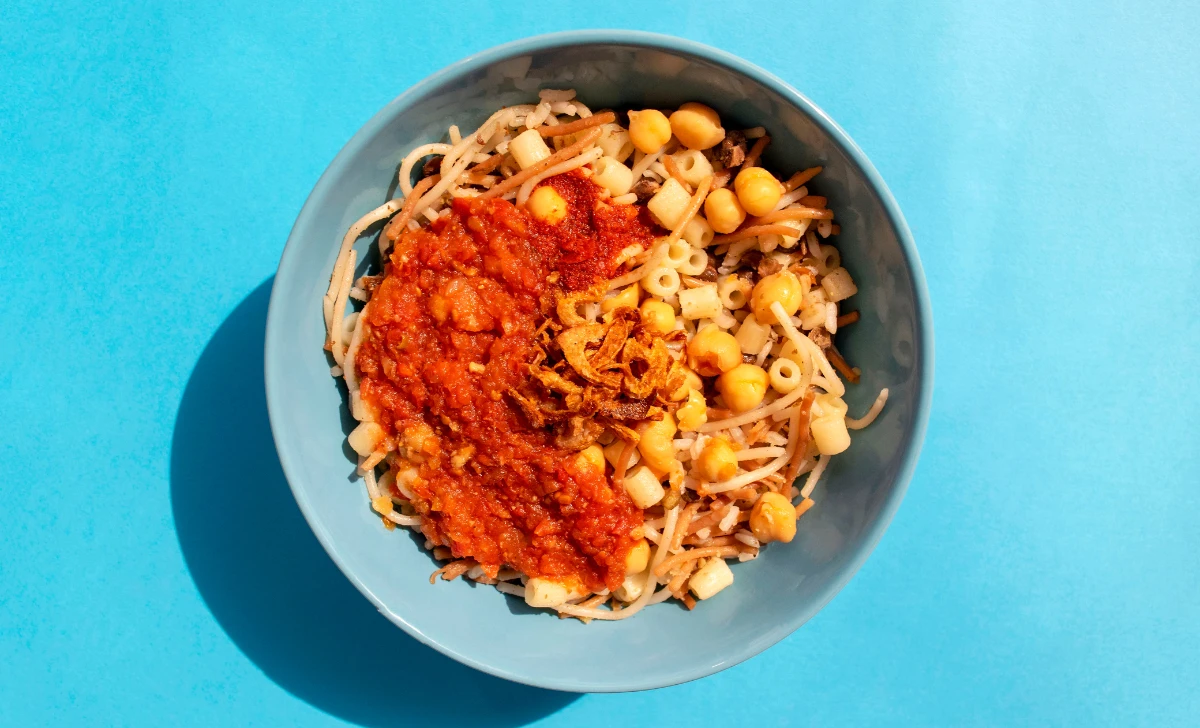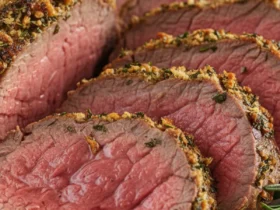If you’re looking for a hearty and comforting dish that’s packed with flavor and history, look no further than the beloved Egyptian classic: Koshari. This delightful combination of rice, lentils, chickpeas, pasta, and a symphony of spices is a true masterpiece that has stood the test of time. In this article, we’ll embark on a culinary adventure to uncover the secrets of crafting the perfect Koshari. So, put on your apron and let’s dive into the world of this tantalizing comfort food.
[ez-toc]
History
The fascinating journey of Koshari, Egypt’s beloved comfort food, traces back to the bustling streets of 19th-century Cairo. Its evolution from a humble street dish to a revered cultural icon is a testament to the power of culinary innovation and the enduring appeal of flavors that resonate with the heart and soul.
Birth of a Street Food Sensation
Koshari’s early days were marked by simplicity and practicality. In a city teeming with diverse cultures and influences, street vendors sought to create a dish that was both filling and affordable. They ingeniously combined readily available ingredients to craft a satisfying meal for Cairo’s working class.
Around the late 1800s, these resourceful vendors began layering rice, lentils, chickpeas, and pasta into a single dish. This amalgamation of staples was then generously spiced and adorned with a tomato-based sauce. The pièce de résistance? A crown of crispy fried onions that added a delightful crunch and a touch of indulgence.
Rising Through the Ranks
As the 20th century dawned, Koshari’s popularity surged beyond the bustling streets and into the homes of everyday Egyptians. Its affordability and wholesome goodness made it a staple for families seeking a hearty and economical meal.
The dish’s rise to prominence was aided by its representation of Egypt’s rich cultural tapestry. Koshari’s ingredients—rice introduced by Persians, pasta by Italians, lentils by Middle Eastern cuisines—symbolized the country’s openness to global influences. Koshari became a culinary ambassador, embodying the unity of diverse cultures within Egypt.
Koshari’s Place in Modern Times
Koshari’s journey from street food to cultural emblem is a story of resilience and adaptation. It weathered economic changes, political shifts, and global trends, all while remaining true to its roots. As Egypt embraced modernization, Koshari evolved as well.
In recent years, Koshari has experienced a resurgence in popularity, not only within Egypt but also on an international scale. Food enthusiasts, chefs, and bloggers have taken this classic dish and put their own unique spins on it. Koshari festivals, both in Egypt and abroad, celebrate the dish’s heritage while showcasing its versatility and contemporary appeal.
Preserving Tradition While Embracing Innovation
Today, Koshari stands as a symbol of tradition, innovation, and unity—a true reflection of Egypt’s culinary spirit. Whether enjoyed by a family gathered around the dinner table, savored at a bustling street corner, or relished in a gourmet restaurant, Koshari continues to captivate hearts and taste buds.
The evolution of Koshari underscores the power of food to transcend boundaries and connect people across time and space. From its humble beginnings as a practical street food to its current status as a celebrated national dish, Koshari remains a testament to the enduring magic of flavors that have stood the test of time. So, the next time you indulge in a hearty bowl of Koshari, remember that you’re savoring not just a meal, but a slice of history and a taste of the vibrant culture that shaped it.
Time
| Step | Time |
|---|---|
| Cooking the Rice | 20 minutes |
| Simmering Lentils and Chickpeas | 40 minutes |
| Boiling Pasta | 10 minutes |
| Crafting the Tomato Sauce | 15 minutes |
| Creating Crunchy Caramelized Onions | 20 minutes |
| Assembling Your Koshari Bowl | 10 minutes |
Total Cooking and Preparation Time: Approximately 1 hour 55 minutes
Please note that the times mentioned above are approximate and may vary based on factors such as the type of cooking equipment used and individual cooking preferences.
Ingredients
| Ingredients | Quantity |
|---|---|
| Long-Grain Rice | 1/2 cup |
| Brown Lentils | 1/4 cup |
| Chickpeas | 1/4 cup |
| Small Macaroni or Spaghetti | 1/2 cup |
| Tomatoes (canned or fresh) | 2 medium |
| Onion | 1 small |
| Garlic Cloves | 2 |
| Ground Cumin | 1 teaspoon |
| Ground Coriander | 1/2 teaspoon |
| Chili Powder | 1/4 teaspoon |
| White Vinegar | 1 tablespoon |
| Cooking Oil | 3 tablespoons |
| Salt and Pepper | To taste |
Please adjust the quantities based on your personal preferences and dietary needs.
Directions
Step 1: Cooking the Perfect Rice
Ingredients:
- Long-Grain Rice
- Water
- Salt
- Rinse the long-grain rice under cold water until the water runs clear. This helps remove excess starch for fluffier rice.
- In a pot, bring water to a boil. Use a 2:1 ratio of water to rice.
- Add a pinch of salt and the rinsed rice to the boiling water.
- Reduce the heat to low, cover the pot, and let the rice simmer for about 18-20 minutes or until the rice is tender and the water is absorbed.
- Once cooked, fluff the rice with a fork and set it aside.
Step 2: Simmering Lentils and Chickpeas
Ingredients:
- Brown Lentils
- Chickpeas
- Turmeric
- Rinse the brown lentils under cold water.
- In a separate pot, combine the rinsed lentils and chickpeas.
- Add enough water to cover the lentils and chickpeas.
- Sprinkle a pinch of turmeric into the pot for color and flavor.
- Bring the mixture to a boil, then reduce the heat to medium-low and let it simmer for about 35-40 minutes, or until the lentils are tender but not mushy.
Step 3: Boiling Pasta to Perfection
Ingredients:
- Small Macaroni or Spaghetti
- Salt
- In a pot of boiling water, add a generous amount of salt.
- Add the small macaroni or spaghetti to the boiling water.
- Cook the pasta according to the package instructions, usually for about 8-10 minutes, or until al dente.
- Drain the pasta and set it aside.
Step 4: Crafting the Tangy Tomato Sauce
Ingredients:
- Tomatoes
- Onion
- Garlic Cloves
- Ground Cumin
- Ground Coriander
- Chili Powder
- Salt and Pepper
- Cooking Oil
- If using fresh tomatoes, blanch them in boiling water for a minute, then peel and chop them. Alternatively, use canned tomatoes and chop them if necessary.
- In a pan, heat cooking oil over medium heat.
- Add finely chopped onion and sauté until translucent.
- Stir in minced garlic cloves and cook for another minute.
- Add ground cumin, ground coriander, and a touch of chili powder for a kick of heat. Cook for a minute until fragrant.
- Add the chopped tomatoes and let the mixture simmer for about 10-12 minutes, or until the tomatoes break down and the sauce thickens.
- Season with salt and pepper to taste. If desired, add a tablespoon of white vinegar for a tangy twist.
Step 5: Creating Crunchy Caramelized Onions
Ingredients:
- Onion
- Cooking Oil
- Slice the onion into thin strips.
- In a pan, heat cooking oil over medium-high heat.
- Add the sliced onion and cook, stirring occasionally, until the onion turns golden brown and crispy, about 15-20 minutes.
- Using a slotted spoon, transfer the caramelized onions to a paper towel-lined plate to drain excess oil.
Step 6: Assembling Your Flavorful Koshari Bowl
- Start by layering the cooked rice as the base of your bowl.
- Top the rice with a generous spoonful of the cooked lentils and chickpeas mixture.
- Add a portion of the cooked pasta on top of the lentils and chickpeas.
- Ladle a generous amount of the tomato sauce over the pasta layer.
- Finish with a generous sprinkling of the crispy caramelized onions.
Step 7: Dive into Culinary Delight
Grab your fork and indulge in the rich symphony of flavors, textures, and aromas that is your very own homemade Koshari. Enjoy!
Feel free to adjust ingredient quantities and steps according to your taste preferences and dietary needs. Bon appétit!
Equipment Required
Nutrition Information
| Nutrient | Per Serving (2-Person Serving) |
|---|---|
| Serving Size | 1 bowl |
| Calories | 550 |
| Total Fat | 12g |
| – Saturated Fat | 1.5g |
| – Trans Fat | 0g |
| Cholesterol | 0mg |
| Sodium | 450mg |
| Total Carbohydrate | 95g |
| – Dietary Fiber | 12g |
| – Sugars | 7g |
| Protein | 16g |
Note: Nutritional values are approximate and may vary based on ingredient brands and portion sizes. It’s recommended to consult a nutrition professional for precise dietary information.
Tips
- Rice Rinsing Ritual: Ensure you rinse the rice thoroughly until the water runs clear. This prevents sticky rice and guarantees fluffiness.
- Luscious Lentils and Chickpeas: For optimal texture, don’t overcook the lentils and chickpeas. They should be tender yet retain their shape.
- Perfect Pasta: Cook the pasta until it’s al dente. Remember, it will continue cooking slightly during assembly.
- Saucy Secrets: Let the tomato sauce simmer to let the flavors meld and the sauce thicken. Don’t forget the touch of white vinegar for that tangy balance.
- Caramelized Onion Charm: Patience is key when caramelizing onions. Low and slow ensures that coveted crispy and sweet result.
- Layering Love: Assemble your Koshari layers with care, creating a visually appealing and flavorful masterpiece.
Pros & Cons
| Pros | Cons |
|---|---|
| ✔️ A Complete Meal in One Bowl | ❌ Carb-Heavy Dish |
| ✔️ Rich in Plant-Based Proteins | ❌ High Sodium Content |
| ✔️ Bursting with Flavor and Spices | ❌ Time-Intensive Preparation |
| ✔️ Versatile: Adaptable to Preferences | ❌ May Require Multiple Ingredients |
| ✔️ Celebrates Cultural Heritage | ❌ Potential for Overeating |
Conclusion
As we bid adieu to our flavorful journey through the world of Koshari, one thing is certain: this Egyptian comfort food is not just a dish; it’s a captivating story woven with history, tradition, and innovation. The symphony of textures and harmonious blend of ingredients in Koshari are a true testament to the magic of culinary artistry.
From the humble origins of Cairo’s bustling streets to its current status as a cultural icon, Koshari has journeyed through time, embracing diverse influences and uniting palates across generations. Its layers of rice, lentils, chickpeas, pasta, and tangy tomato sauce create a mesmerizing ensemble of flavors that dance on your taste buds.
Koshari invites you to embark on a delightful adventure—a journey that transcends geographical boundaries and brings the warmth of Egypt’s culinary heritage to your very kitchen. Whether you’re drawn to its rich history, captivated by its tantalizing aroma, or enticed by the promise of a complete and wholesome meal in a single bowl, Koshari beckons you to dive in and experience a taste that lingers long after the last bite.
So, gather your ingredients, unleash your creativity, and let your culinary prowess shine as you craft your own masterpiece of Koshari. The joy of cooking and the delight of savoring this beloved comfort food await you. Don’t hesitate—take a leap into the world of Koshari and create a memorable, flavorful, and heartwarming experience that will have you returning to this timeless dish time and time again.
Facts
- 1. The Global Fusion Dance 🌎
- Did you know that Koshari’s diverse blend of ingredients mirrors Egypt’s rich cultural tapestry? Just like its people, Koshari’s rice, lentils, and pasta represent global influences, creating a harmonious culinary dance that celebrates unity in diversity. 🌍
- 2. Street Food Serendipity 🚚
- Koshari’s rise from humble street food to cultural icon is a tale of serendipity. Legend has it that a chef accidentally combined leftover rice, lentils, and pasta, and the result was so delightful that Koshari was born! Talk about a delicious accident turned tradition. 🍚
- 3. Pyramid of Flavors 🏰
- Ever wondered why Koshari is often called “Egyptian comfort food”? It’s because this dish’s layers, much like the layers of a pyramid, create a flavor explosion that’s both comforting and sensational. Every bite is like a mini flavor adventure! 🧀
- 4. The Great Tomato Migration 🍅
- Tomatoes weren’t native to Egypt, but Koshari’s tomato sauce became a vibrant symbol of cross-cultural exchange. Introduced by foreign traders, tomatoes found a new home in Koshari and have been mingling with the other ingredients ever since. Talk about making friends across borders! 🌞
- 5. The Koshari Connection: Earth and Sky 🌱
- In ancient Egyptian mythology, the ingredients of Koshari were often associated with earth and sky. Chickpeas, lentils, and onions grew from the earth, while rice symbolized the sky. When combined, they created a dish that bridged the gap between heaven and earth—a true culinary legend! ✨
FAQ’s
Is Koshari a vegetarian dish?
Yes, Koshari is inherently vegetarian, making it a fantastic option for those seeking plant-based meals. Its blend of rice, lentils, chickpeas, and pasta provides ample protein without any meat.
Can I make Koshari gluten-free?
Absolutely! To make Koshari gluten-free, simply replace the regular pasta with gluten-free pasta or swap it out for cooked quinoa for a wholesome alternative.
What are some creative topping ideas?
While crispy caramelized onions are a traditional topping, you can get creative! Try adding roasted nuts, fresh herbs like parsley or cilantro, crumbled feta cheese, or even a drizzle of tahini for a unique twist.
Is Koshari spicy?
Koshari’s level of spiciness can be adjusted to your preference. The chili powder used in the tomato sauce adds a subtle kick, but you can increase or decrease the amount to suit your taste buds.
Can I prepare Koshari in advance?
Yes, you can certainly prepare Koshari in advance. Cook and store the individual components separately, like rice, lentils, pasta, and tomato sauce. When ready to serve, simply reheat and assemble for a quick and satisfying meal.
What’s the origin of Koshari?
Koshari originated in Egypt and has a history that dates back to the late 19th century. It began as a street food staple and has since become a beloved national dish, celebrated for its unique blend of ingredients.
Are there variations of Koshari?
Absolutely! Koshari lends itself to creativity. You can explore modern twists by incorporating different spices or global inspirations by adding unique ingredients. Fusion Koshari and healthier versions with veggies are popular variations.
Can I freeze leftover Koshari?
Yes, you can freeze leftover Koshari. Make sure to store the components separately in airtight containers to maintain their flavors and textures. When reheating, thaw and assemble for a delicious meal.
What’s the key to perfect caramelized onions?
Patience and low heat are crucial for perfectly caramelized onions. Cook them slowly over medium-low heat, stirring occasionally, until they turn golden brown and sweet.
Is Koshari suitable for special occasions?
Absolutely! Koshari’s rich flavors and symbolic history make it a wonderful choice for special occasions. It can add a unique and exotic touch to your celebrations, reflecting the cultural heritage of Egypt in every bite.












Leave a Review